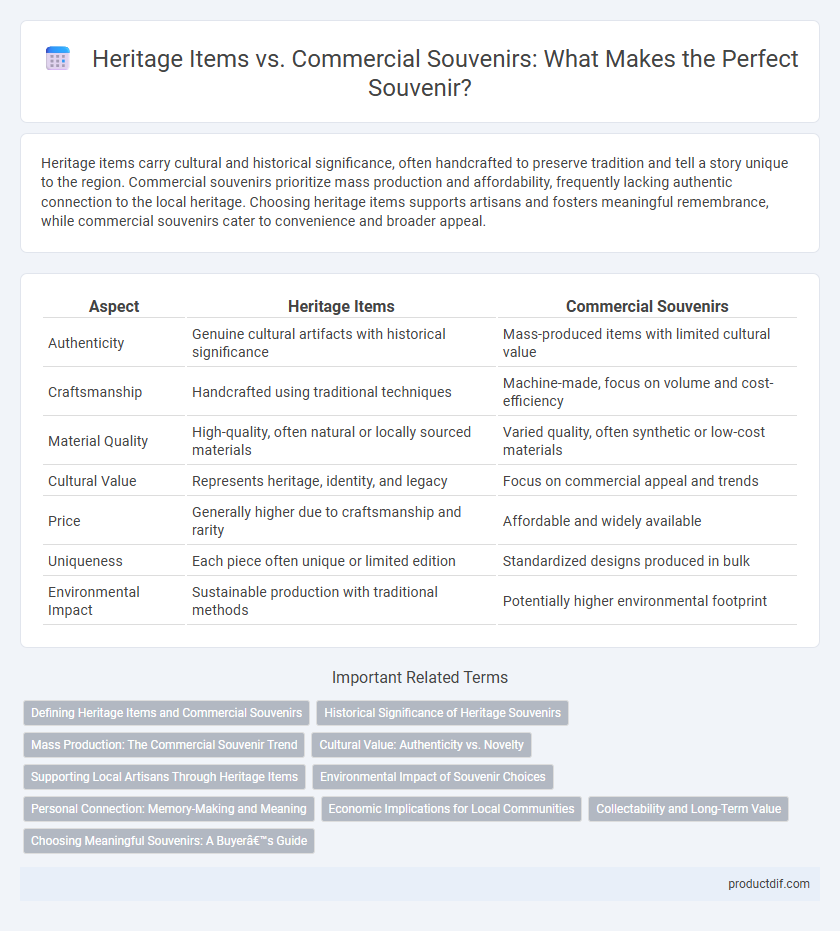Heritage items carry cultural and historical significance, often handcrafted to preserve tradition and tell a story unique to the region. Commercial souvenirs prioritize mass production and affordability, frequently lacking authentic connection to the local heritage. Choosing heritage items supports artisans and fosters meaningful remembrance, while commercial souvenirs cater to convenience and broader appeal.
Table of Comparison
| Aspect | Heritage Items | Commercial Souvenirs |
|---|---|---|
| Authenticity | Genuine cultural artifacts with historical significance | Mass-produced items with limited cultural value |
| Craftsmanship | Handcrafted using traditional techniques | Machine-made, focus on volume and cost-efficiency |
| Material Quality | High-quality, often natural or locally sourced materials | Varied quality, often synthetic or low-cost materials |
| Cultural Value | Represents heritage, identity, and legacy | Focus on commercial appeal and trends |
| Price | Generally higher due to craftsmanship and rarity | Affordable and widely available |
| Uniqueness | Each piece often unique or limited edition | Standardized designs produced in bulk |
| Environmental Impact | Sustainable production with traditional methods | Potentially higher environmental footprint |
Defining Heritage Items and Commercial Souvenirs
Heritage items are authentic artifacts deeply rooted in the cultural, historical, or traditional identity of a community, often handcrafted with materials and techniques passed down through generations. Commercial souvenirs are mass-produced goods designed primarily for tourists, emphasizing accessibility and affordability over cultural significance or artisanal value. Understanding the distinction between heritage items and commercial souvenirs highlights the importance of preserving cultural integrity versus meeting market demand.
Historical Significance of Heritage Souvenirs
Heritage souvenirs possess profound historical significance, often representing cultural traditions and ancestral craftsmanship passed down through generations. These items serve as tangible links to a region's past, embedding stories, rituals, and authentic local identities within each piece. Unlike commercial souvenirs, heritage items emphasize preservation of cultural heritage over mass production, enriching travelers' understanding of history.
Mass Production: The Commercial Souvenir Trend
Commercial souvenirs dominate the market through mass production, often sacrificing cultural authenticity for cost efficiency and wide distribution. Heritage items, by contrast, emphasize artisanal craftsmanship and unique cultural significance, reflecting local traditions and historical narratives. Mass-produced souvenirs prioritize affordability and accessibility, while heritage items preserve and promote cultural identity.
Cultural Value: Authenticity vs. Novelty
Heritage items embody cultural value through their authenticity, preserving traditional craftsmanship and historical significance that connect tourists to the origins and stories of a place. Commercial souvenirs prioritize novelty, often mass-produced and designed for wide appeal rather than cultural accuracy, sacrificing genuine representation for marketability. Choosing heritage items supports cultural preservation and offers a meaningful keepsake that reflects the true identity of the destination.
Supporting Local Artisans Through Heritage Items
Heritage items preserve cultural identity while providing sustainable income for local artisans, ensuring traditional craftsmanship thrives. Unlike mass-produced commercial souvenirs, heritage items showcase authentic materials and techniques unique to their region. Supporting local artisans through these culturally rich souvenirs strengthens community economies and promotes heritage conservation.
Environmental Impact of Souvenir Choices
Heritage items, often crafted using traditional methods and natural materials, tend to have a lower environmental impact compared to mass-produced commercial souvenirs made from plastic and synthetic components. Commercial souvenirs frequently contribute to pollution and excessive waste due to their short lifespan and packaging, while heritage items promote sustainability by supporting local artisans and preserving cultural practices. Choosing heritage souvenirs encourages eco-friendly consumption and helps reduce the environmental footprint associated with tourism.
Personal Connection: Memory-Making and Meaning
Heritage items hold deep personal connections by embodying cultural significance and authentic memories tied to specific traditions or places. Commercial souvenirs often lack this emotional depth, serving primarily as mass-produced reminders of a location rather than meaningful artifacts. Personal connection is strengthened through heritage items, making them powerful memory-making tools that preserve individual and collective identity.
Economic Implications for Local Communities
Heritage items often generate sustainable economic benefits for local communities by preserving traditional crafts and supporting artisans, which enhances cultural tourism and promotes long-term employment. Commercial souvenirs typically drive higher immediate sales but may rely on mass production, leading to limited reinvestment in local economies or cultural preservation. Prioritizing heritage items can strengthen community identity and economic resilience by fostering authentic cultural engagement and retaining financial resources within the region.
Collectability and Long-Term Value
Heritage items often possess higher collectability and long-term value due to their historical significance, rarity, and craftsmanship, making them sought after by serious collectors and cultural enthusiasts. Commercial souvenirs, while widely available and affordable, typically lack unique attributes and intrinsic value, limiting their appeal to short-term mementos rather than valuable keepsakes. Investing in heritage souvenirs can yield appreciation over time, contrasting with the depreciation commonly seen in commercial souvenir markets.
Choosing Meaningful Souvenirs: A Buyer’s Guide
Heritage items embody cultural significance and authentic craftsmanship, making them meaningful souvenirs that preserve local traditions. Commercial souvenirs often prioritize mass production and trend appeal over cultural value, which can dilute the uniqueness of the memento. Buyers should prioritize heritage items for souvenirs to ensure their purchase supports local artisans and reflects genuine cultural heritage.
Heritage Items vs Commercial Souvenirs Infographic

 productdif.com
productdif.com